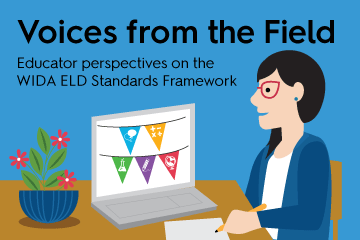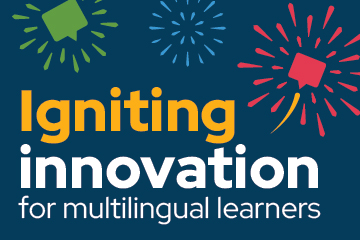WIDA Voices from the Field: Collaboration as a tool for language development

“The long-standing culture of teacher isolation and individualism, together with teachers’ preference to preserve their individual autonomy, may hinder deep-level collaboration.” (Vangrieken, Dochy, Raes, & Kyndt, 2015, p. 36)
When we think of teaching, how often do we envision a solitary person, alone in front of their students or sitting in an empty classroom planning lessons and grading papers? As teachers, we often close our doors and do much of the work involved with teaching in isolation because it is easier that way. But what do we – and more importantly, our students – stand to gain when we are given, and when we embrace, opportunities to truly collaborate with our peers? Collaboration requires time, energy, and a commitment to making it work. But when we do, the results are worth what we invested.
Collaboration has been a foundation of our educational careers since we started teaching more than 15 years ago. Working collaboratively with other teachers has taught us how to
- plan more effectively
- expose ourselves to new curricula
- help us develop new pedagogical strategies
- push us to be more reflective
- lessen our individual loads
Collaboration has also pushed us to think deeply about how we practice our craft, including how we plan instruction together. We have found that for authentic collaboration to occur, both educators must enter the partnership with a clear understanding of its reciprocal nature and how both partners contribute from their expertise in either content or language. Approached in this manner, collaboration is not only rewarding, but it also has the potential to enhance full and meaningful access, particularly for multilingual learners. In a true collaboration between content and language teachers, multilingual learners have access to grade level, standards-based academic content, and are equipped to meet the challenging linguistic demands of content area classes.
The Big Ideas and the other components of the WIDA English Language Development Standards Framework, 2020 Edition, provide essential ingredients for ensuring that the symbiotic relationship between content and language are at the forefront of every lesson.
While there are demonstrated benefits for both teachers and students when teachers collaborate with each other, many schools and districts do not do enough to support it. Vital components that nurture successful collaboration in classrooms of multilingual learners include structures such as
- schedules that account for collaborative planning time
- team meetings
- focused professional development.
With these components in place, it is also important for each teacher to make the necessary commitments to create an effective collaborative partnership. Here are a few areas to consider whenever embarking on a collaborative partnership:
- Professional partnership and responsibilities
- Form a collaborative partnership with mutual respect and trust
- Establish and maintain norms and expectations for professional interactions like planning habits and decision-making
- Review communication and collaboration styles and the best ways to communicate for planning and any additional issues that might arise
- Identify daily, weekly and monthly responsibilities before the school year begins
- Lean on each other's strengths and support each other’s growth
- Instructional and classroom culture responsibilities when co-teaching
- Share equal responsibility for classroom climate and culture
- Share whole-class instruction responsibilities
- Teach all students regardless of identification
- Pre-plan and develop daily lesson plans, post-planning and collaborative reflection
- Provide equal access and responsibility in grading, feedback and family engagement
- Consider classroom set-up and upkeep
- Utilize a variety of co-teaching structures
- Structural support for collaboration
- Time before the school year begins to start the collaboration process
- Weekly common planning time
- Extra planning time during the year
- Administrative support
- Ongoing PD to develop co-planning and co-teaching strategies
- District level support
How the WIDA ELD Standards Framework enables effective collaboration between content and language teachers
Right now, many educators are thinking about how to use the 2020 Edition effectively across content classes, and we have found that the best way to do this is through established collaborative partnerships between content and language specialists. The mutual trust in these partnerships allows teachers to leverage each other’s expertise and give both content and language specialists opportunities to be in the driver’s seat when planning.
The 2020 Edition offers several tools designed to support these collaborative planning conversations. For example, Collaboration is one of the four Big Ideas that anchors the ELD Standards Framework. Language Expectations tightly weave in academic content and language, making visible the language students need to develop to meet grade-level academic content standards. The Collaborative Planning for Content and Language Integration section offers sample steps and a scenario between two collaborating teachers as a jump-off point for curricular conversations. (See Figure 4-2: Sample Collaborative Planning Process, p. 237, 2020 Edition.)
When planning lessons and units that integrate content and language, it often seems that students need an overwhelming array of skills and language to demonstrate grade-level mastery of content. In our collaborative partnership, we have found that when we approach lesson planning by prioritizing depth over breadth, we can better identify the language demands of what we are teaching in each unit. The grade-level cluster Language Expectations can help us do that. Through the process of specifying the highest leverage Language Functions and Language Features of a unit, we can then identify which aspects of language to tackle explicitly across the unit.
To demonstrate what collaborative planning looks like in action, we have outlined the reciprocal process an ELA and language specialist used to plan a mini unit for 9th grade students titled How the Media Works to Control your Mind: Persuasive Techniques in the Media. Most importantly, the teachers determined the Language Expectations for the mini unit together, which then provided the foundation to create necessary scaffolds to support both content and language development. Both teachers should engage in this planning process, but these steps indicate which specialist is facilitating/driving each part of the planning conversation for this mini unit.
- Content Specialist: ELA teacher facilitates the discussion on choosing the ELA standards, theme, essential question and summative assessment in the unit plan.
- Together: Both teachers identify WIDA ELD.LA and ELD.SIP to guide a focus on language in the unit.
- Language Specialist: ELD teacher facilitates the discussion around setting goals for content-driven language learning by determining the Language Expectations. The ELD teacher knows that the class is working on claim/evidence/reasoning and refers to the Key Language Uses. The teachers agree on Argue.
- Together: Given that the performance task is a debate, both teachers choose the expressive communication mode. Still, the teachers know they will support students in using both communication modes (interpretive and expressive) as one is dependent on the other.
- Together: Teachers determine what knowledge, skills and practices students are expected to demonstrate for the task at hand. Teachers determine what explicit patterns of argumentation students need to develop from a linguistic perspective (Language Functions) to demonstrate mastery of the content standard. From there, teachers determine a range of vocabulary and grammar (Language Features) students might need to carry out the Language Functions.
- Using the Language Expectations, Functions and Features, both teachers plan to explicitly teach the language students may need for the debate, building in supports and scaffolds for students at various proficiency levels.
Our experience as collaborating teachers has taught us how to better support multilingual learners as they engage in challenging ELA content. We have developed confidence in using the WIDA ELD Standards Framework to integrate content and language for our students and learned how to bring our language expertise and our content expertise into planning lessons and units.
Whether you are using a full co-teaching model or are beginning to foster new co-planning conversations in your school, the WIDA ELD Standards Framework can support this important collaboration. It is clear to us that true collaboration using the framework to integrate content and language is a process that requires substantial structural support, a partnership between content and language specialists that provides them equal voice, and a commitment to student learning at the heart of the work. When these components are in place, full and meaningful access is possible for all educators and students.
About the series: Voices from the Field
Fernanda Marinho Kray, WIDA ELD Standards Framework project lead, and Margo Gottlieb, WIDA co-founder and consultant, have been hearing from a variety of educators about how they are making sense of the 2020 Edition. In response, the WIDA ELD Standards Framework team established this “Voices from the Field" series to present ideas, practices and tools for educators as they explore various avenues for standards framework implementation.
About the authors
Martha Boisselle is an EL instructional coach for Salem Public Schools Kristen Leathers is an ESL teacher and department head at Boston Public Schools.
To stay informed about WIDA ELD Standards Framework resources, tools and services, use the News Signup form to manage email preferences and select WIDA ELD Standards as an interest area.





